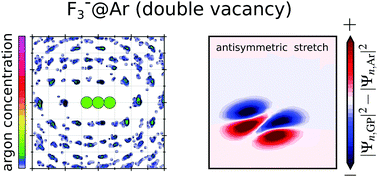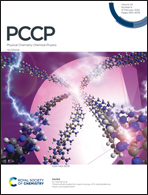Theoretical modeling of molecules in weakly interacting environments: trifluoride anions in argon†
Abstract
The properties of molecules can be affected by the presence of a host environment. Even in inert rare gas matrices such effects are observable, as for instance in matrix isolation spectroscopy. In this work we study the trifluoride anion in cryogenic argon environments. To investigate the structure and vibrational properties of the guest–host systems, a potential energy surface of compound F−3–argon structures is determined from ab initio calculations with the CCSD(T)-F12b approach. Argon environments are probed with minima hopping optimizations of extended trifluoride–argon clusters. The vibrations of F−3 within the optimized environments are examined with anharmonic vibrational analyses. Among the three identified structural surroundings for the trifluoride, two are characterized by relatively favorable guest–host and host–host interactions as well as vibrational zero-point energies. A striking dependence of the trifluoride properties on the particular argon environment reveals the delicate influence of the host atoms on the guest molecule. Very good agreement with measured data suggests that in experiment F−3 occupies a double-vacancy site.

- This article is part of the themed collection: 2022 PCCP HOT Articles


 Please wait while we load your content...
Please wait while we load your content...